Understanding Privity of Contract and Estate in Property Law
VerifiedAdded on 2023/06/04
|11
|3120
|265
AI Summary
This article discusses the concept of privity of contract and estate in property law, and how it affects parties in a leasehold agreement. It explains the rules regarding sub-tenancy, and the relationships between the head-landlord, head-tenant, and sub-tenant. The article also provides an application of these rules to a hypothetical scenario. Additionally, it discusses the difference between a representation and a sales puff in property law, and how to determine whether a statement is a term or a representation.
Contribute Materials
Your contribution can guide someone’s learning journey. Share your
documents today.
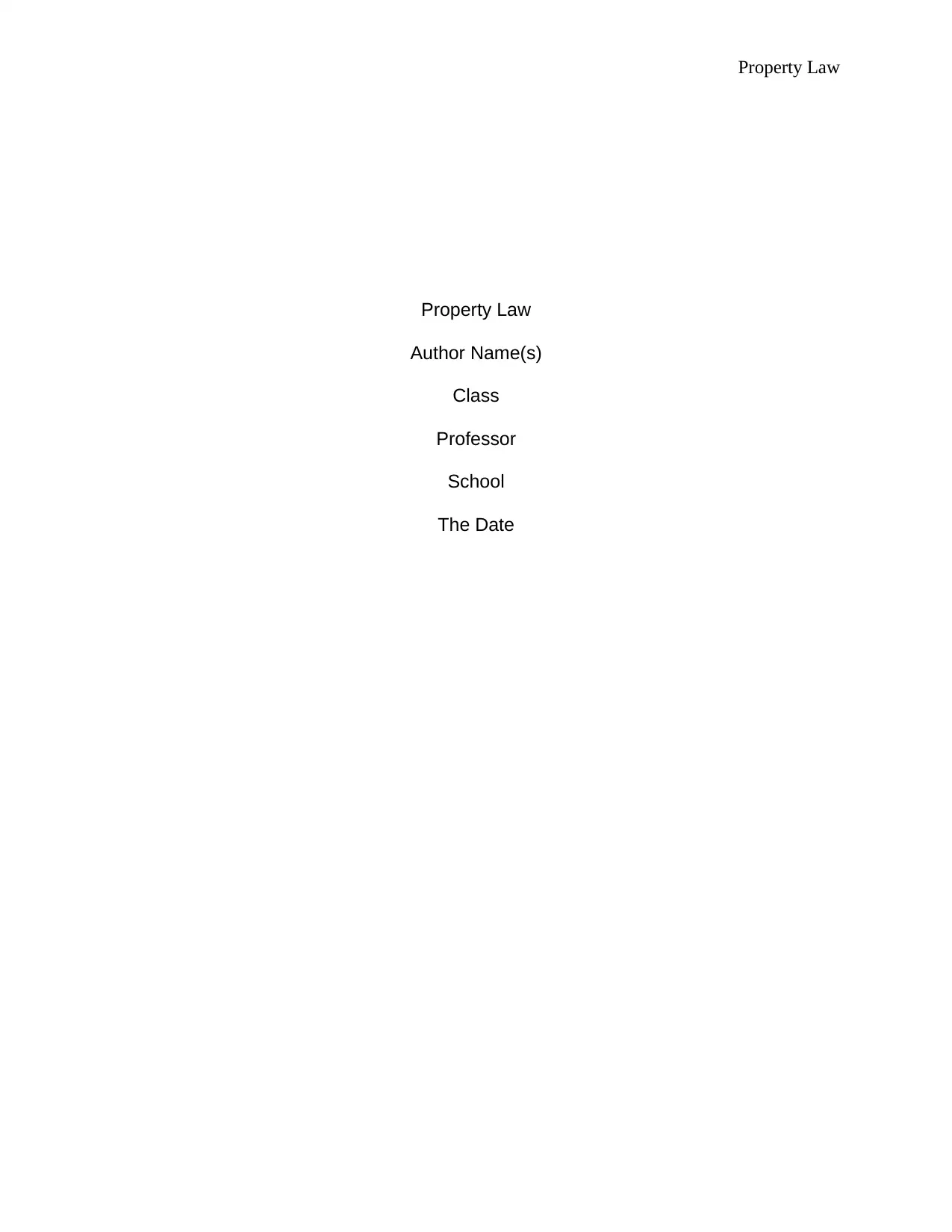
Property Law
Property Law
Author Name(s)
Class
Professor
School
The Date
Property Law
Author Name(s)
Class
Professor
School
The Date
Secure Best Marks with AI Grader
Need help grading? Try our AI Grader for instant feedback on your assignments.
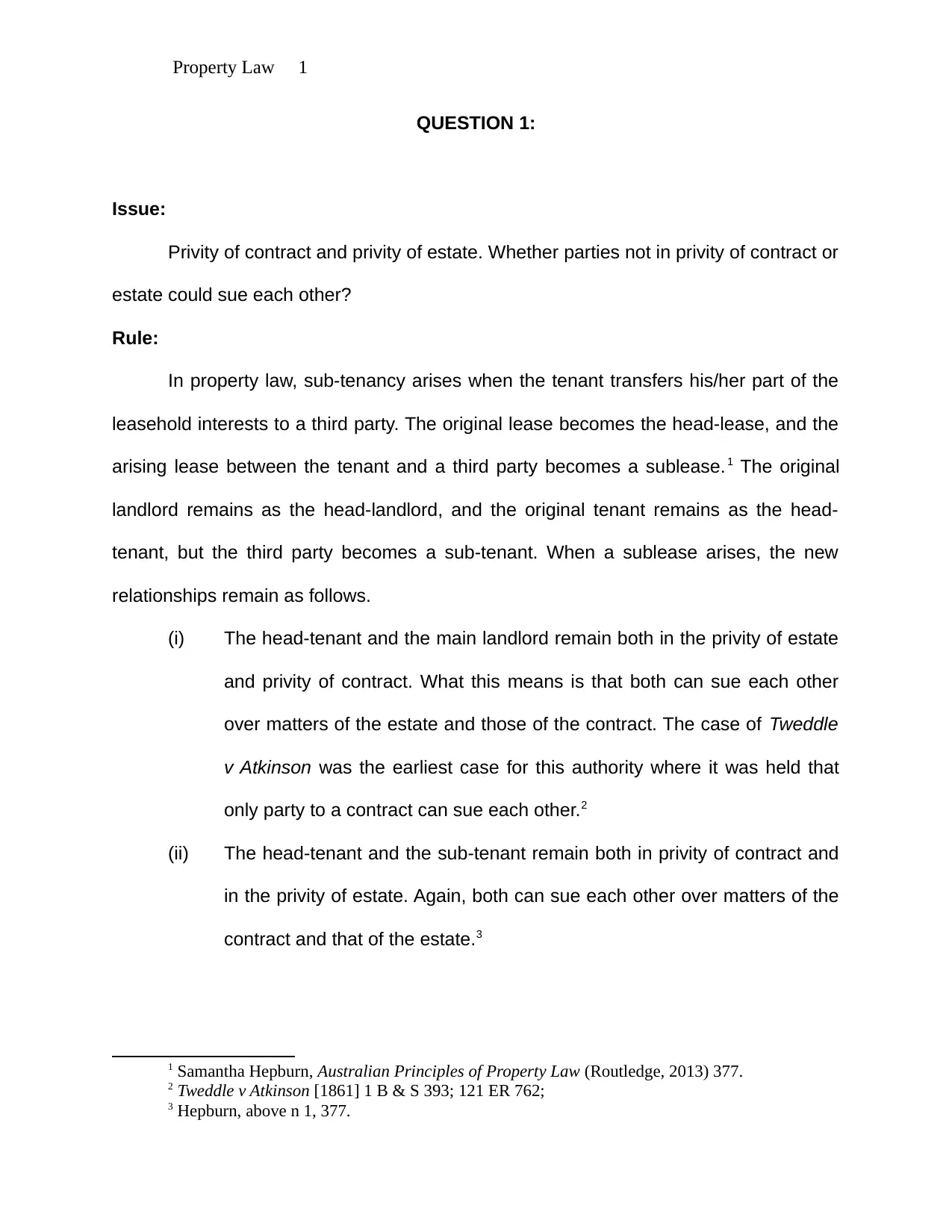
Property Law 1
QUESTION 1:
Issue:
Privity of contract and privity of estate. Whether parties not in privity of contract or
estate could sue each other?
Rule:
In property law, sub-tenancy arises when the tenant transfers his/her part of the
leasehold interests to a third party. The original lease becomes the head-lease, and the
arising lease between the tenant and a third party becomes a sublease.1 The original
landlord remains as the head-landlord, and the original tenant remains as the head-
tenant, but the third party becomes a sub-tenant. When a sublease arises, the new
relationships remain as follows.
(i) The head-tenant and the main landlord remain both in the privity of estate
and privity of contract. What this means is that both can sue each other
over matters of the estate and those of the contract. The case of Tweddle
v Atkinson was the earliest case for this authority where it was held that
only party to a contract can sue each other.2
(ii) The head-tenant and the sub-tenant remain both in privity of contract and
in the privity of estate. Again, both can sue each other over matters of the
contract and that of the estate.3
1 Samantha Hepburn, Australian Principles of Property Law (Routledge, 2013) 377.
2 Tweddle v Atkinson [1861] 1 B & S 393; 121 ER 762;
3 Hepburn, above n 1, 377.
QUESTION 1:
Issue:
Privity of contract and privity of estate. Whether parties not in privity of contract or
estate could sue each other?
Rule:
In property law, sub-tenancy arises when the tenant transfers his/her part of the
leasehold interests to a third party. The original lease becomes the head-lease, and the
arising lease between the tenant and a third party becomes a sublease.1 The original
landlord remains as the head-landlord, and the original tenant remains as the head-
tenant, but the third party becomes a sub-tenant. When a sublease arises, the new
relationships remain as follows.
(i) The head-tenant and the main landlord remain both in the privity of estate
and privity of contract. What this means is that both can sue each other
over matters of the estate and those of the contract. The case of Tweddle
v Atkinson was the earliest case for this authority where it was held that
only party to a contract can sue each other.2
(ii) The head-tenant and the sub-tenant remain both in privity of contract and
in the privity of estate. Again, both can sue each other over matters of the
contract and that of the estate.3
1 Samantha Hepburn, Australian Principles of Property Law (Routledge, 2013) 377.
2 Tweddle v Atkinson [1861] 1 B & S 393; 121 ER 762;
3 Hepburn, above n 1, 377.
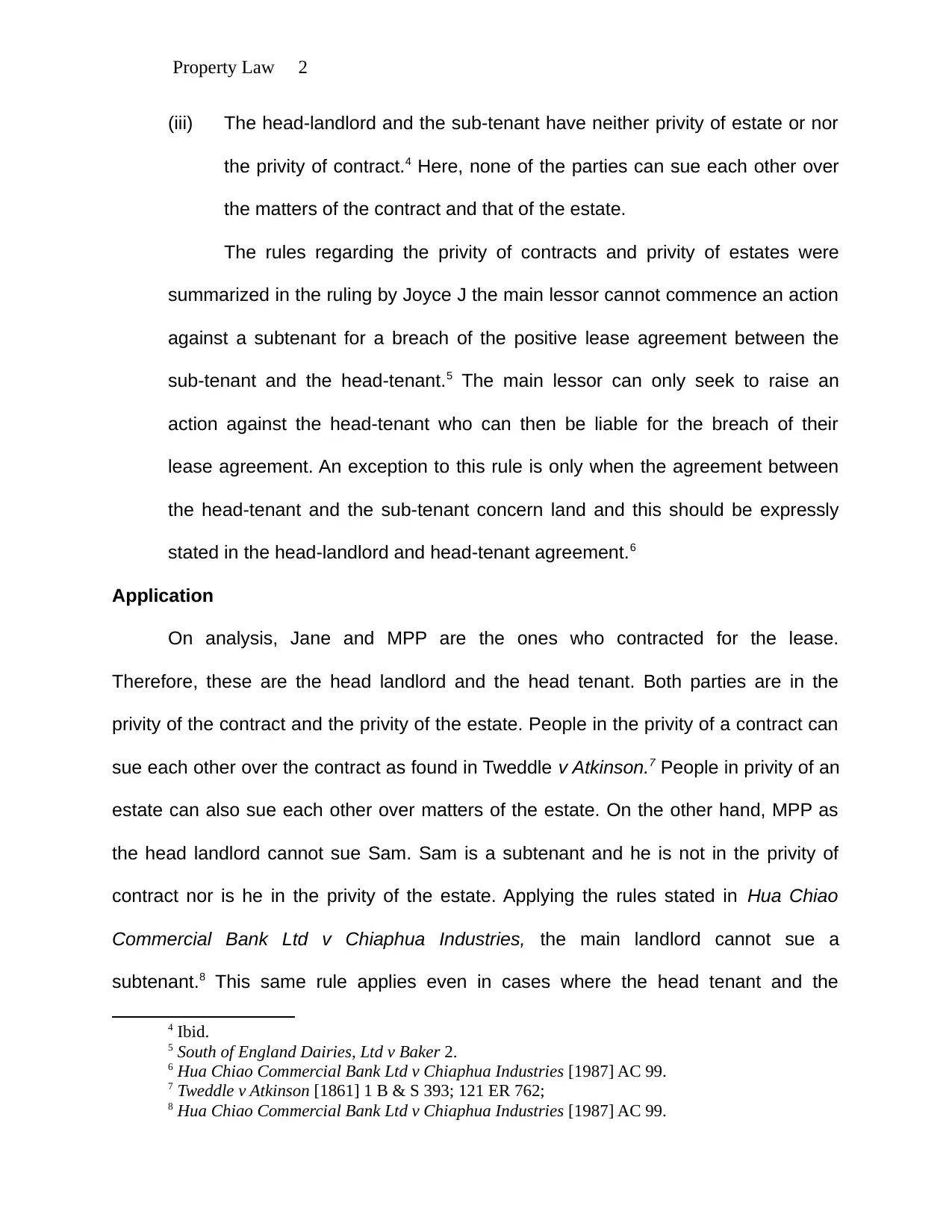
Property Law 2
(iii) The head-landlord and the sub-tenant have neither privity of estate or nor
the privity of contract.4 Here, none of the parties can sue each other over
the matters of the contract and that of the estate.
The rules regarding the privity of contracts and privity of estates were
summarized in the ruling by Joyce J the main lessor cannot commence an action
against a subtenant for a breach of the positive lease agreement between the
sub-tenant and the head-tenant.5 The main lessor can only seek to raise an
action against the head-tenant who can then be liable for the breach of their
lease agreement. An exception to this rule is only when the agreement between
the head-tenant and the sub-tenant concern land and this should be expressly
stated in the head-landlord and head-tenant agreement.6
Application
On analysis, Jane and MPP are the ones who contracted for the lease.
Therefore, these are the head landlord and the head tenant. Both parties are in the
privity of the contract and the privity of the estate. People in the privity of a contract can
sue each other over the contract as found in Tweddle v Atkinson.7 People in privity of an
estate can also sue each other over matters of the estate. On the other hand, MPP as
the head landlord cannot sue Sam. Sam is a subtenant and he is not in the privity of
contract nor is he in the privity of the estate. Applying the rules stated in Hua Chiao
Commercial Bank Ltd v Chiaphua Industries, the main landlord cannot sue a
subtenant.8 This same rule applies even in cases where the head tenant and the
4 Ibid.
5 South of England Dairies, Ltd v Baker 2.
6 Hua Chiao Commercial Bank Ltd v Chiaphua Industries [1987] AC 99.
7 Tweddle v Atkinson [1861] 1 B & S 393; 121 ER 762;
8 Hua Chiao Commercial Bank Ltd v Chiaphua Industries [1987] AC 99.
(iii) The head-landlord and the sub-tenant have neither privity of estate or nor
the privity of contract.4 Here, none of the parties can sue each other over
the matters of the contract and that of the estate.
The rules regarding the privity of contracts and privity of estates were
summarized in the ruling by Joyce J the main lessor cannot commence an action
against a subtenant for a breach of the positive lease agreement between the
sub-tenant and the head-tenant.5 The main lessor can only seek to raise an
action against the head-tenant who can then be liable for the breach of their
lease agreement. An exception to this rule is only when the agreement between
the head-tenant and the sub-tenant concern land and this should be expressly
stated in the head-landlord and head-tenant agreement.6
Application
On analysis, Jane and MPP are the ones who contracted for the lease.
Therefore, these are the head landlord and the head tenant. Both parties are in the
privity of the contract and the privity of the estate. People in the privity of a contract can
sue each other over the contract as found in Tweddle v Atkinson.7 People in privity of an
estate can also sue each other over matters of the estate. On the other hand, MPP as
the head landlord cannot sue Sam. Sam is a subtenant and he is not in the privity of
contract nor is he in the privity of the estate. Applying the rules stated in Hua Chiao
Commercial Bank Ltd v Chiaphua Industries, the main landlord cannot sue a
subtenant.8 This same rule applies even in cases where the head tenant and the
4 Ibid.
5 South of England Dairies, Ltd v Baker 2.
6 Hua Chiao Commercial Bank Ltd v Chiaphua Industries [1987] AC 99.
7 Tweddle v Atkinson [1861] 1 B & S 393; 121 ER 762;
8 Hua Chiao Commercial Bank Ltd v Chiaphua Industries [1987] AC 99.
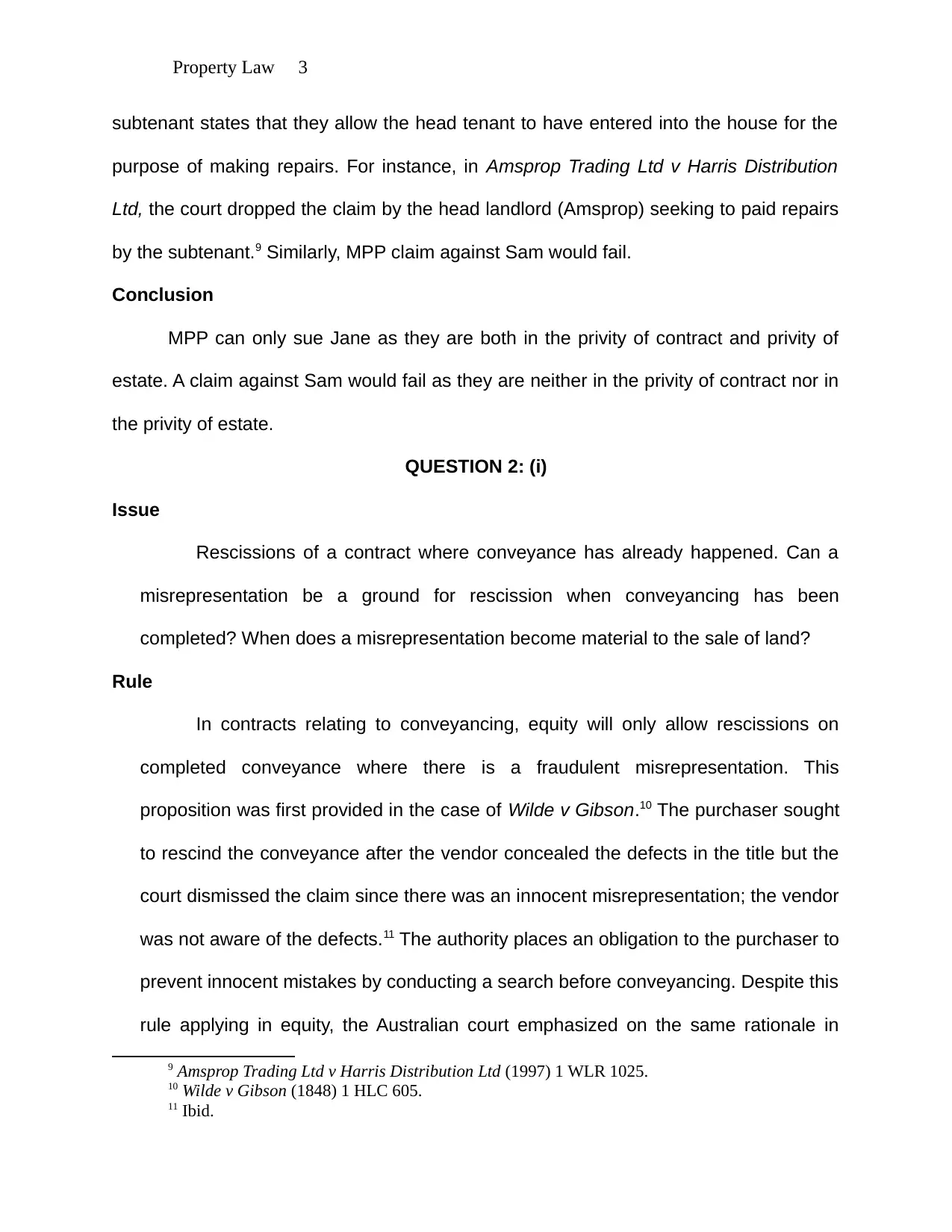
Property Law 3
subtenant states that they allow the head tenant to have entered into the house for the
purpose of making repairs. For instance, in Amsprop Trading Ltd v Harris Distribution
Ltd, the court dropped the claim by the head landlord (Amsprop) seeking to paid repairs
by the subtenant.9 Similarly, MPP claim against Sam would fail.
Conclusion
MPP can only sue Jane as they are both in the privity of contract and privity of
estate. A claim against Sam would fail as they are neither in the privity of contract nor in
the privity of estate.
QUESTION 2: (i)
Issue
Rescissions of a contract where conveyance has already happened. Can a
misrepresentation be a ground for rescission when conveyancing has been
completed? When does a misrepresentation become material to the sale of land?
Rule
In contracts relating to conveyancing, equity will only allow rescissions on
completed conveyance where there is a fraudulent misrepresentation. This
proposition was first provided in the case of Wilde v Gibson.10 The purchaser sought
to rescind the conveyance after the vendor concealed the defects in the title but the
court dismissed the claim since there was an innocent misrepresentation; the vendor
was not aware of the defects.11 The authority places an obligation to the purchaser to
prevent innocent mistakes by conducting a search before conveyancing. Despite this
rule applying in equity, the Australian court emphasized on the same rationale in
9 Amsprop Trading Ltd v Harris Distribution Ltd (1997) 1 WLR 1025.
10 Wilde v Gibson (1848) 1 HLC 605.
11 Ibid.
subtenant states that they allow the head tenant to have entered into the house for the
purpose of making repairs. For instance, in Amsprop Trading Ltd v Harris Distribution
Ltd, the court dropped the claim by the head landlord (Amsprop) seeking to paid repairs
by the subtenant.9 Similarly, MPP claim against Sam would fail.
Conclusion
MPP can only sue Jane as they are both in the privity of contract and privity of
estate. A claim against Sam would fail as they are neither in the privity of contract nor in
the privity of estate.
QUESTION 2: (i)
Issue
Rescissions of a contract where conveyance has already happened. Can a
misrepresentation be a ground for rescission when conveyancing has been
completed? When does a misrepresentation become material to the sale of land?
Rule
In contracts relating to conveyancing, equity will only allow rescissions on
completed conveyance where there is a fraudulent misrepresentation. This
proposition was first provided in the case of Wilde v Gibson.10 The purchaser sought
to rescind the conveyance after the vendor concealed the defects in the title but the
court dismissed the claim since there was an innocent misrepresentation; the vendor
was not aware of the defects.11 The authority places an obligation to the purchaser to
prevent innocent mistakes by conducting a search before conveyancing. Despite this
rule applying in equity, the Australian court emphasized on the same rationale in
9 Amsprop Trading Ltd v Harris Distribution Ltd (1997) 1 WLR 1025.
10 Wilde v Gibson (1848) 1 HLC 605.
11 Ibid.
Secure Best Marks with AI Grader
Need help grading? Try our AI Grader for instant feedback on your assignments.
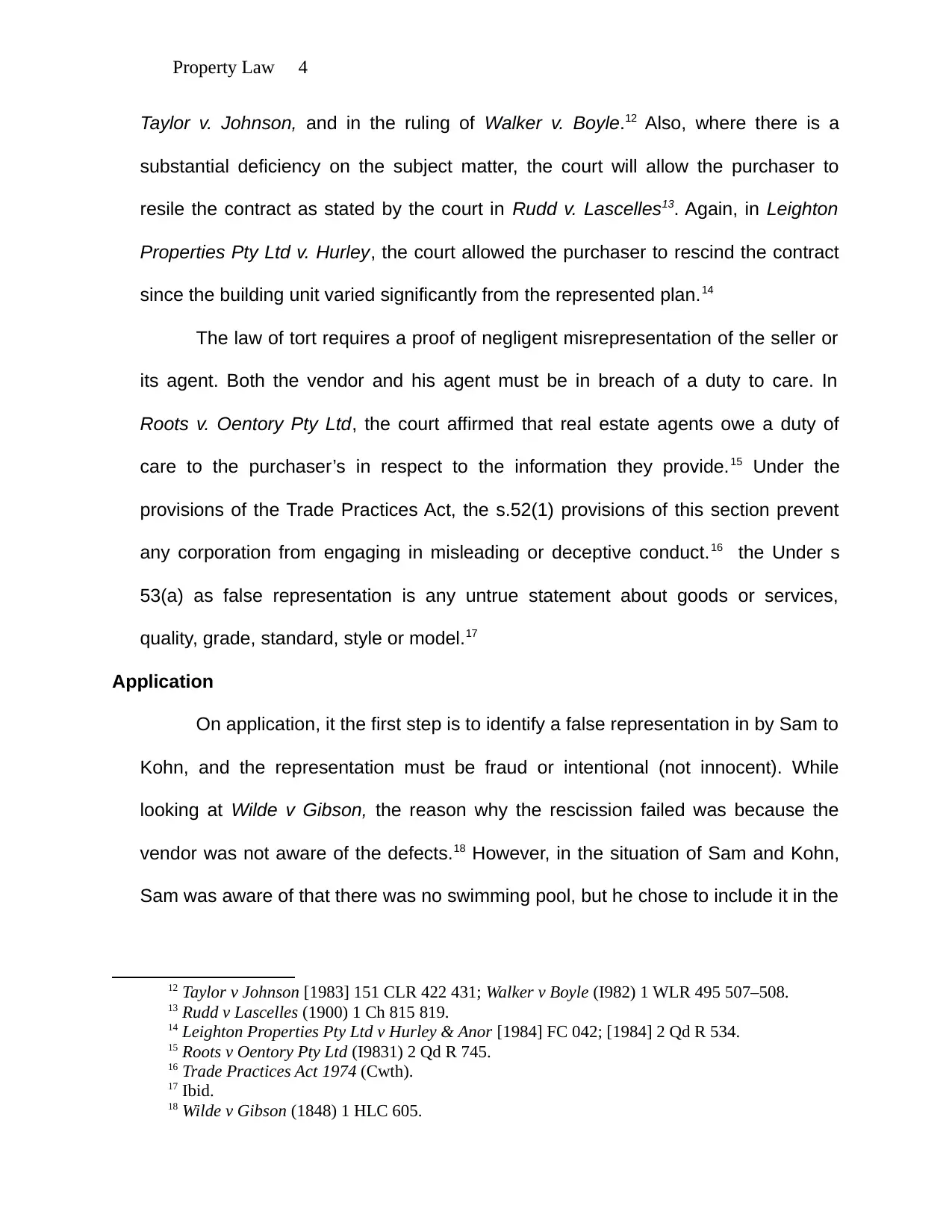
Property Law 4
Taylor v. Johnson, and in the ruling of Walker v. Boyle.12 Also, where there is a
substantial deficiency on the subject matter, the court will allow the purchaser to
resile the contract as stated by the court in Rudd v. Lascelles13. Again, in Leighton
Properties Pty Ltd v. Hurley, the court allowed the purchaser to rescind the contract
since the building unit varied significantly from the represented plan.14
The law of tort requires a proof of negligent misrepresentation of the seller or
its agent. Both the vendor and his agent must be in breach of a duty to care. In
Roots v. Oentory Pty Ltd, the court affirmed that real estate agents owe a duty of
care to the purchaser’s in respect to the information they provide.15 Under the
provisions of the Trade Practices Act, the s.52(1) provisions of this section prevent
any corporation from engaging in misleading or deceptive conduct.16 the Under s
53(a) as false representation is any untrue statement about goods or services,
quality, grade, standard, style or model.17
Application
On application, it the first step is to identify a false representation in by Sam to
Kohn, and the representation must be fraud or intentional (not innocent). While
looking at Wilde v Gibson, the reason why the rescission failed was because the
vendor was not aware of the defects.18 However, in the situation of Sam and Kohn,
Sam was aware of that there was no swimming pool, but he chose to include it in the
12 Taylor v Johnson [1983] 151 CLR 422 431; Walker v Boyle (I982) 1 WLR 495 507–508.
13 Rudd v Lascelles (1900) 1 Ch 815 819.
14 Leighton Properties Pty Ltd v Hurley & Anor [1984] FC 042; [1984] 2 Qd R 534.
15 Roots v Oentory Pty Ltd (I9831) 2 Qd R 745.
16 Trade Practices Act 1974 (Cwth).
17 Ibid.
18 Wilde v Gibson (1848) 1 HLC 605.
Taylor v. Johnson, and in the ruling of Walker v. Boyle.12 Also, where there is a
substantial deficiency on the subject matter, the court will allow the purchaser to
resile the contract as stated by the court in Rudd v. Lascelles13. Again, in Leighton
Properties Pty Ltd v. Hurley, the court allowed the purchaser to rescind the contract
since the building unit varied significantly from the represented plan.14
The law of tort requires a proof of negligent misrepresentation of the seller or
its agent. Both the vendor and his agent must be in breach of a duty to care. In
Roots v. Oentory Pty Ltd, the court affirmed that real estate agents owe a duty of
care to the purchaser’s in respect to the information they provide.15 Under the
provisions of the Trade Practices Act, the s.52(1) provisions of this section prevent
any corporation from engaging in misleading or deceptive conduct.16 the Under s
53(a) as false representation is any untrue statement about goods or services,
quality, grade, standard, style or model.17
Application
On application, it the first step is to identify a false representation in by Sam to
Kohn, and the representation must be fraud or intentional (not innocent). While
looking at Wilde v Gibson, the reason why the rescission failed was because the
vendor was not aware of the defects.18 However, in the situation of Sam and Kohn,
Sam was aware of that there was no swimming pool, but he chose to include it in the
12 Taylor v Johnson [1983] 151 CLR 422 431; Walker v Boyle (I982) 1 WLR 495 507–508.
13 Rudd v Lascelles (1900) 1 Ch 815 819.
14 Leighton Properties Pty Ltd v Hurley & Anor [1984] FC 042; [1984] 2 Qd R 534.
15 Roots v Oentory Pty Ltd (I9831) 2 Qd R 745.
16 Trade Practices Act 1974 (Cwth).
17 Ibid.
18 Wilde v Gibson (1848) 1 HLC 605.
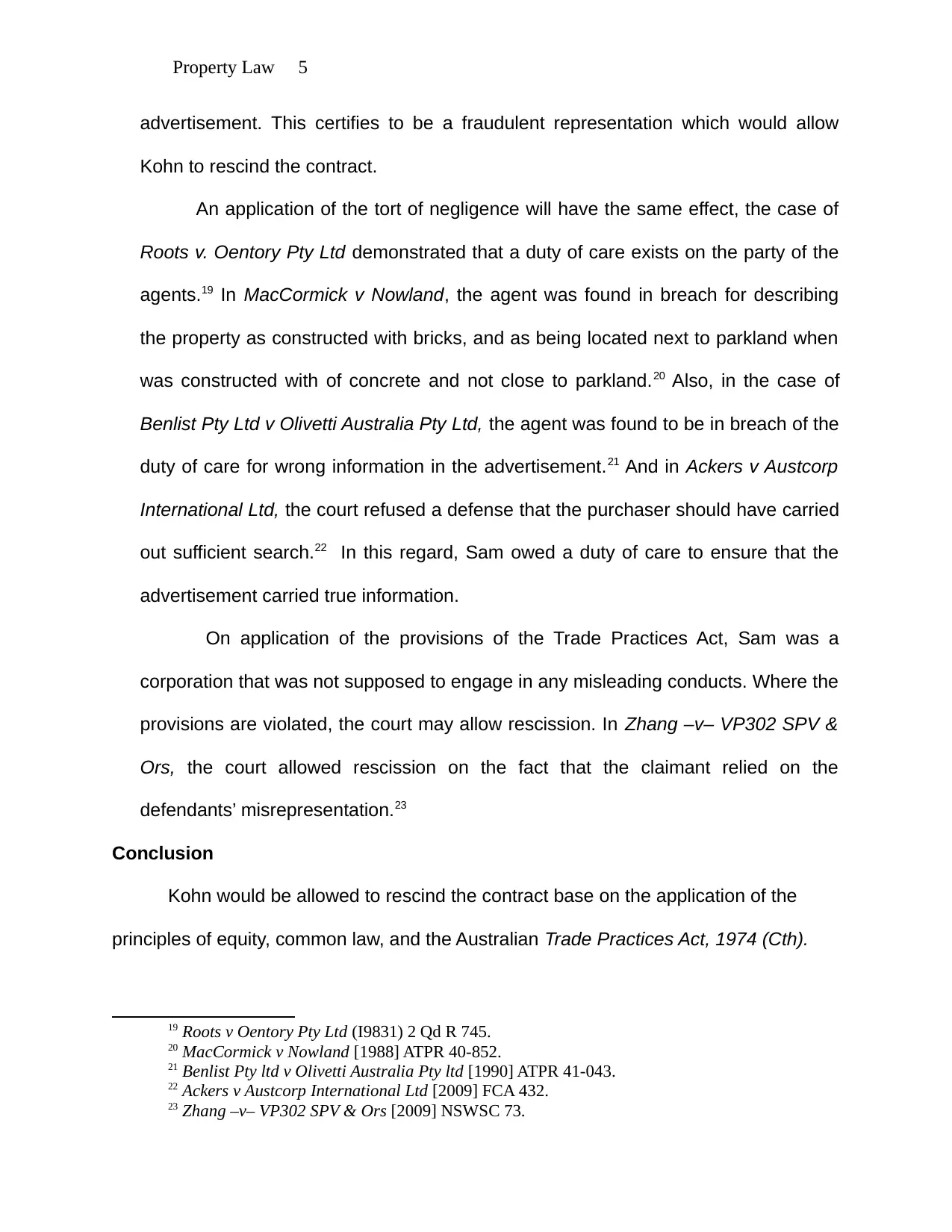
Property Law 5
advertisement. This certifies to be a fraudulent representation which would allow
Kohn to rescind the contract.
An application of the tort of negligence will have the same effect, the case of
Roots v. Oentory Pty Ltd demonstrated that a duty of care exists on the party of the
agents.19 In MacCormick v Nowland, the agent was found in breach for describing
the property as constructed with bricks, and as being located next to parkland when
was constructed with of concrete and not close to parkland.20 Also, in the case of
Benlist Pty Ltd v Olivetti Australia Pty Ltd, the agent was found to be in breach of the
duty of care for wrong information in the advertisement.21 And in Ackers v Austcorp
International Ltd, the court refused a defense that the purchaser should have carried
out sufficient search.22 In this regard, Sam owed a duty of care to ensure that the
advertisement carried true information.
On application of the provisions of the Trade Practices Act, Sam was a
corporation that was not supposed to engage in any misleading conducts. Where the
provisions are violated, the court may allow rescission. In Zhang –v– VP302 SPV &
Ors, the court allowed rescission on the fact that the claimant relied on the
defendants’ misrepresentation.23
Conclusion
Kohn would be allowed to rescind the contract base on the application of the
principles of equity, common law, and the Australian Trade Practices Act, 1974 (Cth).
19 Roots v Oentory Pty Ltd (I9831) 2 Qd R 745.
20 MacCormick v Nowland [1988] ATPR 40-852.
21 Benlist Pty ltd v Olivetti Australia Pty ltd [1990] ATPR 41-043.
22 Ackers v Austcorp International Ltd [2009] FCA 432.
23 Zhang –v– VP302 SPV & Ors [2009] NSWSC 73.
advertisement. This certifies to be a fraudulent representation which would allow
Kohn to rescind the contract.
An application of the tort of negligence will have the same effect, the case of
Roots v. Oentory Pty Ltd demonstrated that a duty of care exists on the party of the
agents.19 In MacCormick v Nowland, the agent was found in breach for describing
the property as constructed with bricks, and as being located next to parkland when
was constructed with of concrete and not close to parkland.20 Also, in the case of
Benlist Pty Ltd v Olivetti Australia Pty Ltd, the agent was found to be in breach of the
duty of care for wrong information in the advertisement.21 And in Ackers v Austcorp
International Ltd, the court refused a defense that the purchaser should have carried
out sufficient search.22 In this regard, Sam owed a duty of care to ensure that the
advertisement carried true information.
On application of the provisions of the Trade Practices Act, Sam was a
corporation that was not supposed to engage in any misleading conducts. Where the
provisions are violated, the court may allow rescission. In Zhang –v– VP302 SPV &
Ors, the court allowed rescission on the fact that the claimant relied on the
defendants’ misrepresentation.23
Conclusion
Kohn would be allowed to rescind the contract base on the application of the
principles of equity, common law, and the Australian Trade Practices Act, 1974 (Cth).
19 Roots v Oentory Pty Ltd (I9831) 2 Qd R 745.
20 MacCormick v Nowland [1988] ATPR 40-852.
21 Benlist Pty ltd v Olivetti Australia Pty ltd [1990] ATPR 41-043.
22 Ackers v Austcorp International Ltd [2009] FCA 432.
23 Zhang –v– VP302 SPV & Ors [2009] NSWSC 73.
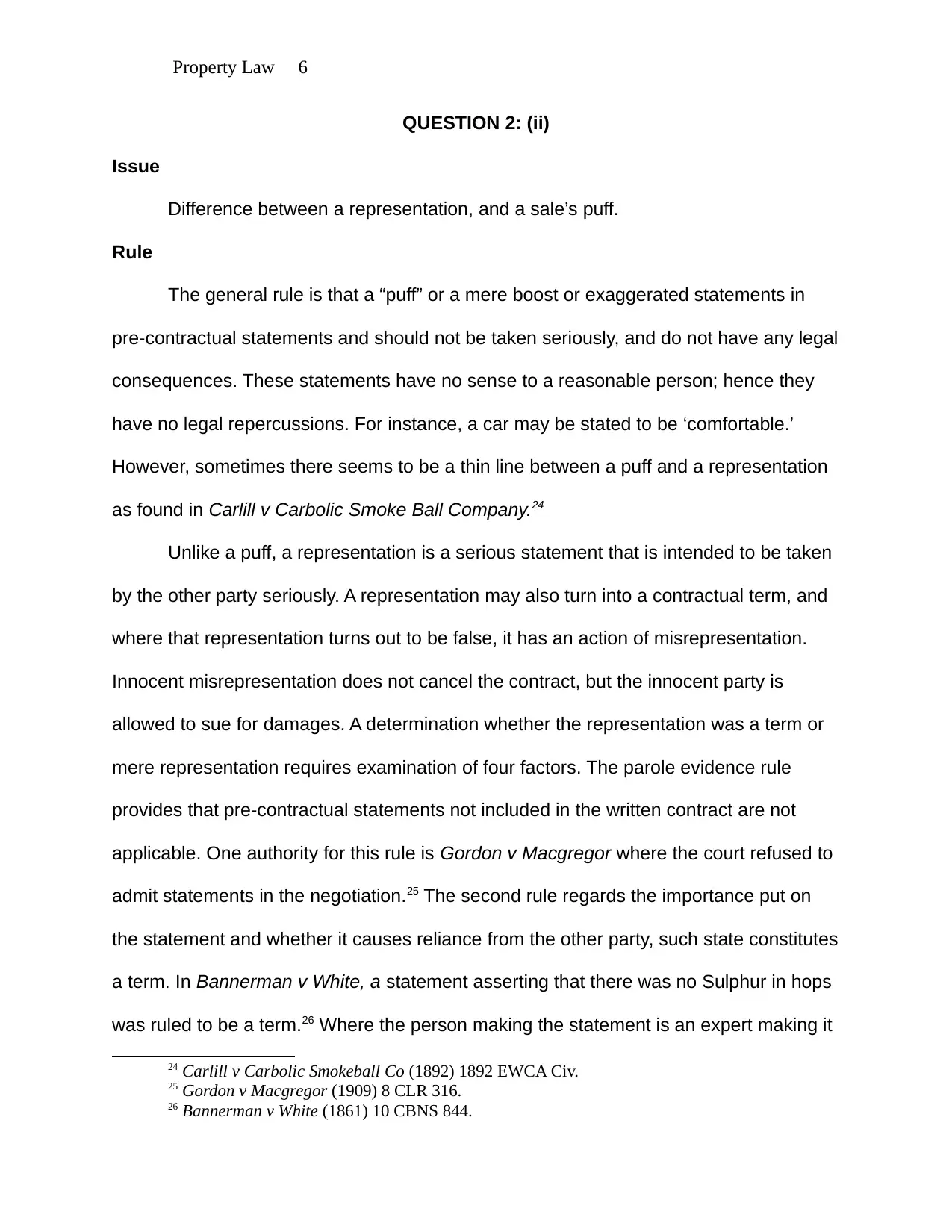
Property Law 6
QUESTION 2: (ii)
Issue
Difference between a representation, and a sale’s puff.
Rule
The general rule is that a “puff” or a mere boost or exaggerated statements in
pre-contractual statements and should not be taken seriously, and do not have any legal
consequences. These statements have no sense to a reasonable person; hence they
have no legal repercussions. For instance, a car may be stated to be ‘comfortable.’
However, sometimes there seems to be a thin line between a puff and a representation
as found in Carlill v Carbolic Smoke Ball Company.24
Unlike a puff, a representation is a serious statement that is intended to be taken
by the other party seriously. A representation may also turn into a contractual term, and
where that representation turns out to be false, it has an action of misrepresentation.
Innocent misrepresentation does not cancel the contract, but the innocent party is
allowed to sue for damages. A determination whether the representation was a term or
mere representation requires examination of four factors. The parole evidence rule
provides that pre-contractual statements not included in the written contract are not
applicable. One authority for this rule is Gordon v Macgregor where the court refused to
admit statements in the negotiation.25 The second rule regards the importance put on
the statement and whether it causes reliance from the other party, such state constitutes
a term. In Bannerman v White, a statement asserting that there was no Sulphur in hops
was ruled to be a term.26 Where the person making the statement is an expert making it
24 Carlill v Carbolic Smokeball Co (1892) 1892 EWCA Civ.
25 Gordon v Macgregor (1909) 8 CLR 316.
26 Bannerman v White (1861) 10 CBNS 844.
QUESTION 2: (ii)
Issue
Difference between a representation, and a sale’s puff.
Rule
The general rule is that a “puff” or a mere boost or exaggerated statements in
pre-contractual statements and should not be taken seriously, and do not have any legal
consequences. These statements have no sense to a reasonable person; hence they
have no legal repercussions. For instance, a car may be stated to be ‘comfortable.’
However, sometimes there seems to be a thin line between a puff and a representation
as found in Carlill v Carbolic Smoke Ball Company.24
Unlike a puff, a representation is a serious statement that is intended to be taken
by the other party seriously. A representation may also turn into a contractual term, and
where that representation turns out to be false, it has an action of misrepresentation.
Innocent misrepresentation does not cancel the contract, but the innocent party is
allowed to sue for damages. A determination whether the representation was a term or
mere representation requires examination of four factors. The parole evidence rule
provides that pre-contractual statements not included in the written contract are not
applicable. One authority for this rule is Gordon v Macgregor where the court refused to
admit statements in the negotiation.25 The second rule regards the importance put on
the statement and whether it causes reliance from the other party, such state constitutes
a term. In Bannerman v White, a statement asserting that there was no Sulphur in hops
was ruled to be a term.26 Where the person making the statement is an expert making it
24 Carlill v Carbolic Smokeball Co (1892) 1892 EWCA Civ.
25 Gordon v Macgregor (1909) 8 CLR 316.
26 Bannerman v White (1861) 10 CBNS 844.
Paraphrase This Document
Need a fresh take? Get an instant paraphrase of this document with our AI Paraphraser
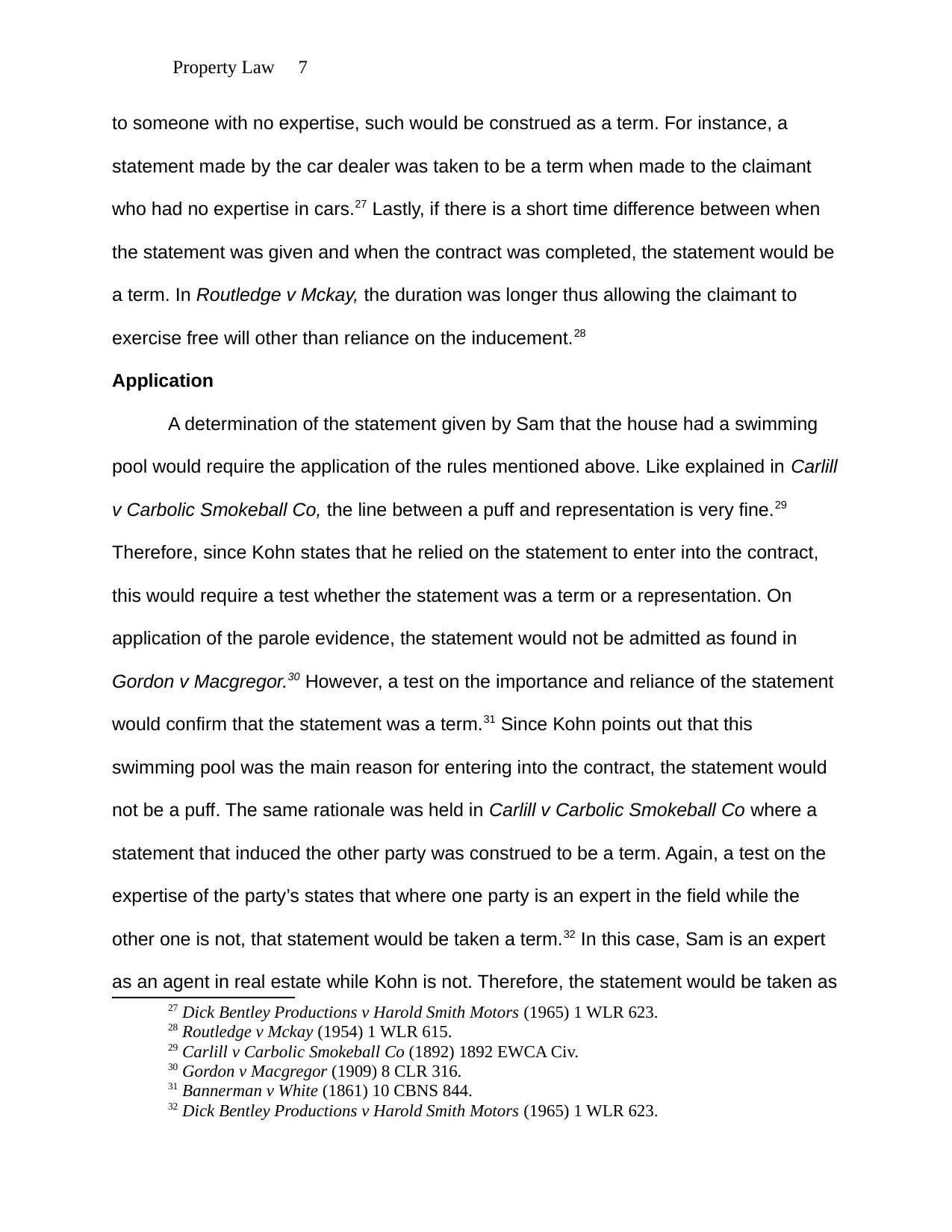
Property Law 7
to someone with no expertise, such would be construed as a term. For instance, a
statement made by the car dealer was taken to be a term when made to the claimant
who had no expertise in cars.27 Lastly, if there is a short time difference between when
the statement was given and when the contract was completed, the statement would be
a term. In Routledge v Mckay, the duration was longer thus allowing the claimant to
exercise free will other than reliance on the inducement.28
Application
A determination of the statement given by Sam that the house had a swimming
pool would require the application of the rules mentioned above. Like explained in Carlill
v Carbolic Smokeball Co, the line between a puff and representation is very fine.29
Therefore, since Kohn states that he relied on the statement to enter into the contract,
this would require a test whether the statement was a term or a representation. On
application of the parole evidence, the statement would not be admitted as found in
Gordon v Macgregor.30 However, a test on the importance and reliance of the statement
would confirm that the statement was a term.31 Since Kohn points out that this
swimming pool was the main reason for entering into the contract, the statement would
not be a puff. The same rationale was held in Carlill v Carbolic Smokeball Co where a
statement that induced the other party was construed to be a term. Again, a test on the
expertise of the party’s states that where one party is an expert in the field while the
other one is not, that statement would be taken a term.32 In this case, Sam is an expert
as an agent in real estate while Kohn is not. Therefore, the statement would be taken as
27 Dick Bentley Productions v Harold Smith Motors (1965) 1 WLR 623.
28 Routledge v Mckay (1954) 1 WLR 615.
29 Carlill v Carbolic Smokeball Co (1892) 1892 EWCA Civ.
30 Gordon v Macgregor (1909) 8 CLR 316.
31 Bannerman v White (1861) 10 CBNS 844.
32 Dick Bentley Productions v Harold Smith Motors (1965) 1 WLR 623.
to someone with no expertise, such would be construed as a term. For instance, a
statement made by the car dealer was taken to be a term when made to the claimant
who had no expertise in cars.27 Lastly, if there is a short time difference between when
the statement was given and when the contract was completed, the statement would be
a term. In Routledge v Mckay, the duration was longer thus allowing the claimant to
exercise free will other than reliance on the inducement.28
Application
A determination of the statement given by Sam that the house had a swimming
pool would require the application of the rules mentioned above. Like explained in Carlill
v Carbolic Smokeball Co, the line between a puff and representation is very fine.29
Therefore, since Kohn states that he relied on the statement to enter into the contract,
this would require a test whether the statement was a term or a representation. On
application of the parole evidence, the statement would not be admitted as found in
Gordon v Macgregor.30 However, a test on the importance and reliance of the statement
would confirm that the statement was a term.31 Since Kohn points out that this
swimming pool was the main reason for entering into the contract, the statement would
not be a puff. The same rationale was held in Carlill v Carbolic Smokeball Co where a
statement that induced the other party was construed to be a term. Again, a test on the
expertise of the party’s states that where one party is an expert in the field while the
other one is not, that statement would be taken a term.32 In this case, Sam is an expert
as an agent in real estate while Kohn is not. Therefore, the statement would be taken as
27 Dick Bentley Productions v Harold Smith Motors (1965) 1 WLR 623.
28 Routledge v Mckay (1954) 1 WLR 615.
29 Carlill v Carbolic Smokeball Co (1892) 1892 EWCA Civ.
30 Gordon v Macgregor (1909) 8 CLR 316.
31 Bannerman v White (1861) 10 CBNS 844.
32 Dick Bentley Productions v Harold Smith Motors (1965) 1 WLR 623.
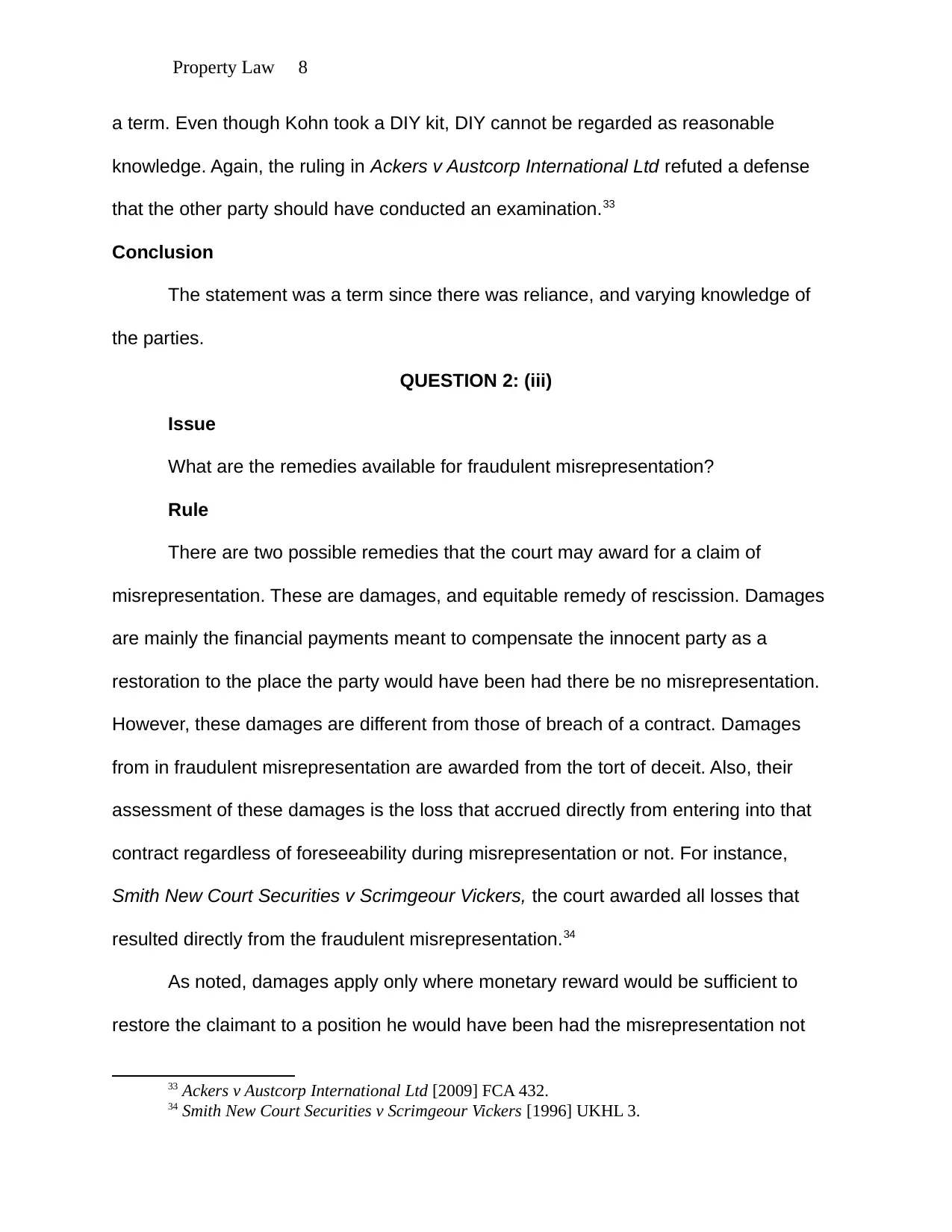
Property Law 8
a term. Even though Kohn took a DIY kit, DIY cannot be regarded as reasonable
knowledge. Again, the ruling in Ackers v Austcorp International Ltd refuted a defense
that the other party should have conducted an examination.33
Conclusion
The statement was a term since there was reliance, and varying knowledge of
the parties.
QUESTION 2: (iii)
Issue
What are the remedies available for fraudulent misrepresentation?
Rule
There are two possible remedies that the court may award for a claim of
misrepresentation. These are damages, and equitable remedy of rescission. Damages
are mainly the financial payments meant to compensate the innocent party as a
restoration to the place the party would have been had there be no misrepresentation.
However, these damages are different from those of breach of a contract. Damages
from in fraudulent misrepresentation are awarded from the tort of deceit. Also, their
assessment of these damages is the loss that accrued directly from entering into that
contract regardless of foreseeability during misrepresentation or not. For instance,
Smith New Court Securities v Scrimgeour Vickers, the court awarded all losses that
resulted directly from the fraudulent misrepresentation.34
As noted, damages apply only where monetary reward would be sufficient to
restore the claimant to a position he would have been had the misrepresentation not
33 Ackers v Austcorp International Ltd [2009] FCA 432.
34 Smith New Court Securities v Scrimgeour Vickers [1996] UKHL 3.
a term. Even though Kohn took a DIY kit, DIY cannot be regarded as reasonable
knowledge. Again, the ruling in Ackers v Austcorp International Ltd refuted a defense
that the other party should have conducted an examination.33
Conclusion
The statement was a term since there was reliance, and varying knowledge of
the parties.
QUESTION 2: (iii)
Issue
What are the remedies available for fraudulent misrepresentation?
Rule
There are two possible remedies that the court may award for a claim of
misrepresentation. These are damages, and equitable remedy of rescission. Damages
are mainly the financial payments meant to compensate the innocent party as a
restoration to the place the party would have been had there be no misrepresentation.
However, these damages are different from those of breach of a contract. Damages
from in fraudulent misrepresentation are awarded from the tort of deceit. Also, their
assessment of these damages is the loss that accrued directly from entering into that
contract regardless of foreseeability during misrepresentation or not. For instance,
Smith New Court Securities v Scrimgeour Vickers, the court awarded all losses that
resulted directly from the fraudulent misrepresentation.34
As noted, damages apply only where monetary reward would be sufficient to
restore the claimant to a position he would have been had the misrepresentation not
33 Ackers v Austcorp International Ltd [2009] FCA 432.
34 Smith New Court Securities v Scrimgeour Vickers [1996] UKHL 3.
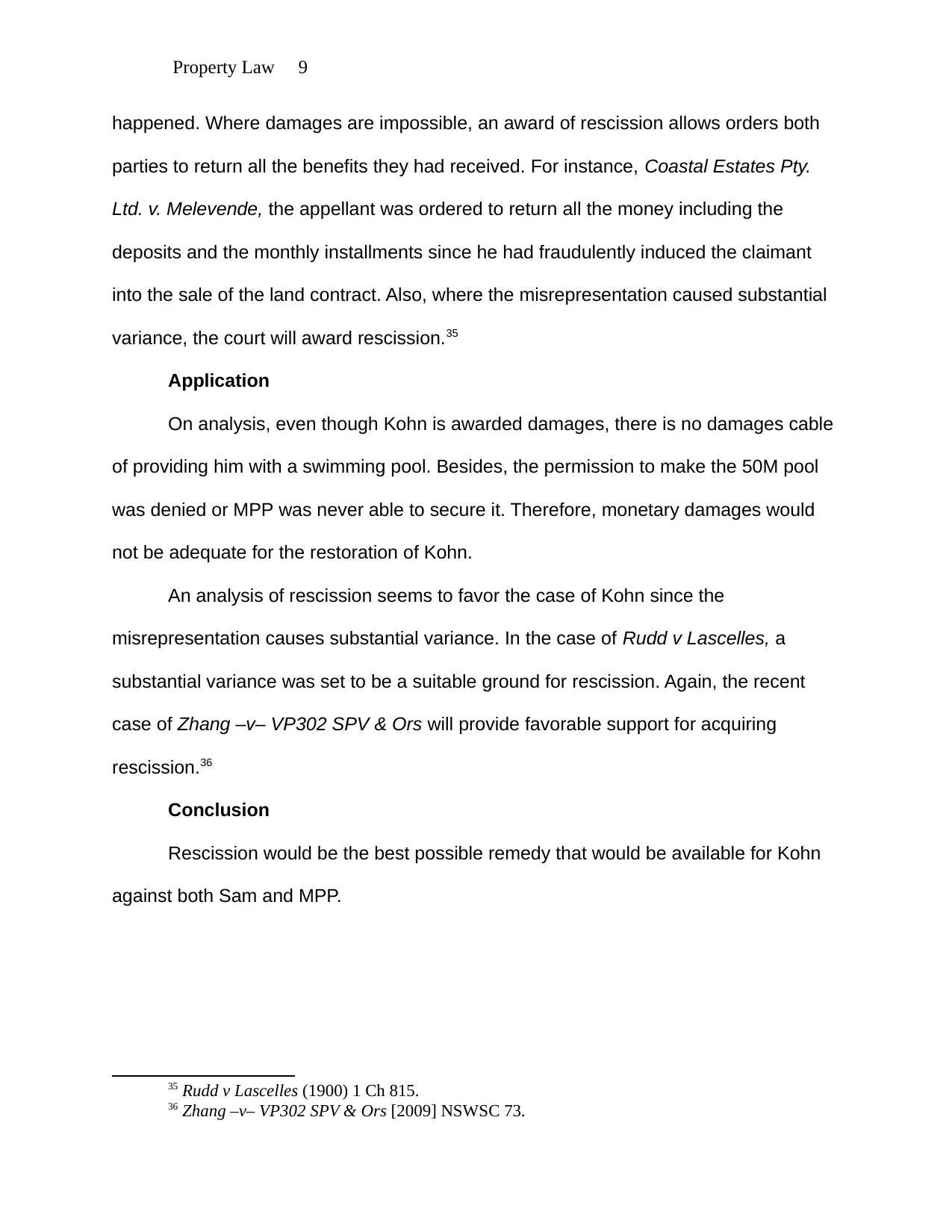
Property Law 9
happened. Where damages are impossible, an award of rescission allows orders both
parties to return all the benefits they had received. For instance, Coastal Estates Pty.
Ltd. v. Melevende, the appellant was ordered to return all the money including the
deposits and the monthly installments since he had fraudulently induced the claimant
into the sale of the land contract. Also, where the misrepresentation caused substantial
variance, the court will award rescission.35
Application
On analysis, even though Kohn is awarded damages, there is no damages cable
of providing him with a swimming pool. Besides, the permission to make the 50M pool
was denied or MPP was never able to secure it. Therefore, monetary damages would
not be adequate for the restoration of Kohn.
An analysis of rescission seems to favor the case of Kohn since the
misrepresentation causes substantial variance. In the case of Rudd v Lascelles, a
substantial variance was set to be a suitable ground for rescission. Again, the recent
case of Zhang –v– VP302 SPV & Ors will provide favorable support for acquiring
rescission.36
Conclusion
Rescission would be the best possible remedy that would be available for Kohn
against both Sam and MPP.
35 Rudd v Lascelles (1900) 1 Ch 815.
36 Zhang –v– VP302 SPV & Ors [2009] NSWSC 73.
happened. Where damages are impossible, an award of rescission allows orders both
parties to return all the benefits they had received. For instance, Coastal Estates Pty.
Ltd. v. Melevende, the appellant was ordered to return all the money including the
deposits and the monthly installments since he had fraudulently induced the claimant
into the sale of the land contract. Also, where the misrepresentation caused substantial
variance, the court will award rescission.35
Application
On analysis, even though Kohn is awarded damages, there is no damages cable
of providing him with a swimming pool. Besides, the permission to make the 50M pool
was denied or MPP was never able to secure it. Therefore, monetary damages would
not be adequate for the restoration of Kohn.
An analysis of rescission seems to favor the case of Kohn since the
misrepresentation causes substantial variance. In the case of Rudd v Lascelles, a
substantial variance was set to be a suitable ground for rescission. Again, the recent
case of Zhang –v– VP302 SPV & Ors will provide favorable support for acquiring
rescission.36
Conclusion
Rescission would be the best possible remedy that would be available for Kohn
against both Sam and MPP.
35 Rudd v Lascelles (1900) 1 Ch 815.
36 Zhang –v– VP302 SPV & Ors [2009] NSWSC 73.
Secure Best Marks with AI Grader
Need help grading? Try our AI Grader for instant feedback on your assignments.
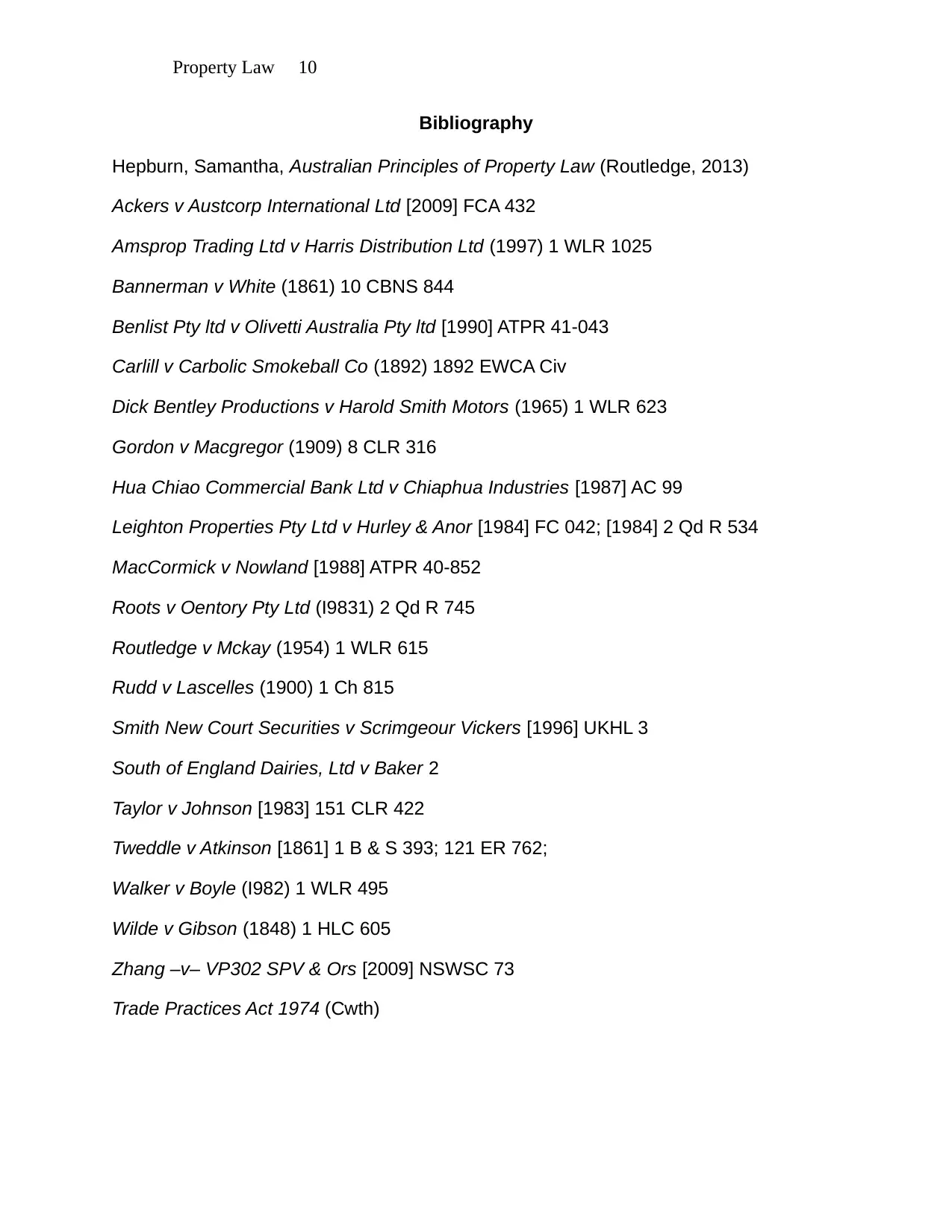
Property Law 10
Bibliography
Hepburn, Samantha, Australian Principles of Property Law (Routledge, 2013)
Ackers v Austcorp International Ltd [2009] FCA 432
Amsprop Trading Ltd v Harris Distribution Ltd (1997) 1 WLR 1025
Bannerman v White (1861) 10 CBNS 844
Benlist Pty ltd v Olivetti Australia Pty ltd [1990] ATPR 41-043
Carlill v Carbolic Smokeball Co (1892) 1892 EWCA Civ
Dick Bentley Productions v Harold Smith Motors (1965) 1 WLR 623
Gordon v Macgregor (1909) 8 CLR 316
Hua Chiao Commercial Bank Ltd v Chiaphua Industries [1987] AC 99
Leighton Properties Pty Ltd v Hurley & Anor [1984] FC 042; [1984] 2 Qd R 534
MacCormick v Nowland [1988] ATPR 40-852
Roots v Oentory Pty Ltd (I9831) 2 Qd R 745
Routledge v Mckay (1954) 1 WLR 615
Rudd v Lascelles (1900) 1 Ch 815
Smith New Court Securities v Scrimgeour Vickers [1996] UKHL 3
South of England Dairies, Ltd v Baker 2
Taylor v Johnson [1983] 151 CLR 422
Tweddle v Atkinson [1861] 1 B & S 393; 121 ER 762;
Walker v Boyle (I982) 1 WLR 495
Wilde v Gibson (1848) 1 HLC 605
Zhang –v– VP302 SPV & Ors [2009] NSWSC 73
Trade Practices Act 1974 (Cwth)
Bibliography
Hepburn, Samantha, Australian Principles of Property Law (Routledge, 2013)
Ackers v Austcorp International Ltd [2009] FCA 432
Amsprop Trading Ltd v Harris Distribution Ltd (1997) 1 WLR 1025
Bannerman v White (1861) 10 CBNS 844
Benlist Pty ltd v Olivetti Australia Pty ltd [1990] ATPR 41-043
Carlill v Carbolic Smokeball Co (1892) 1892 EWCA Civ
Dick Bentley Productions v Harold Smith Motors (1965) 1 WLR 623
Gordon v Macgregor (1909) 8 CLR 316
Hua Chiao Commercial Bank Ltd v Chiaphua Industries [1987] AC 99
Leighton Properties Pty Ltd v Hurley & Anor [1984] FC 042; [1984] 2 Qd R 534
MacCormick v Nowland [1988] ATPR 40-852
Roots v Oentory Pty Ltd (I9831) 2 Qd R 745
Routledge v Mckay (1954) 1 WLR 615
Rudd v Lascelles (1900) 1 Ch 815
Smith New Court Securities v Scrimgeour Vickers [1996] UKHL 3
South of England Dairies, Ltd v Baker 2
Taylor v Johnson [1983] 151 CLR 422
Tweddle v Atkinson [1861] 1 B & S 393; 121 ER 762;
Walker v Boyle (I982) 1 WLR 495
Wilde v Gibson (1848) 1 HLC 605
Zhang –v– VP302 SPV & Ors [2009] NSWSC 73
Trade Practices Act 1974 (Cwth)
1 out of 11
Related Documents
Your All-in-One AI-Powered Toolkit for Academic Success.
+13062052269
info@desklib.com
Available 24*7 on WhatsApp / Email
![[object Object]](/_next/static/media/star-bottom.7253800d.svg)
Unlock your academic potential
© 2024 | Zucol Services PVT LTD | All rights reserved.

